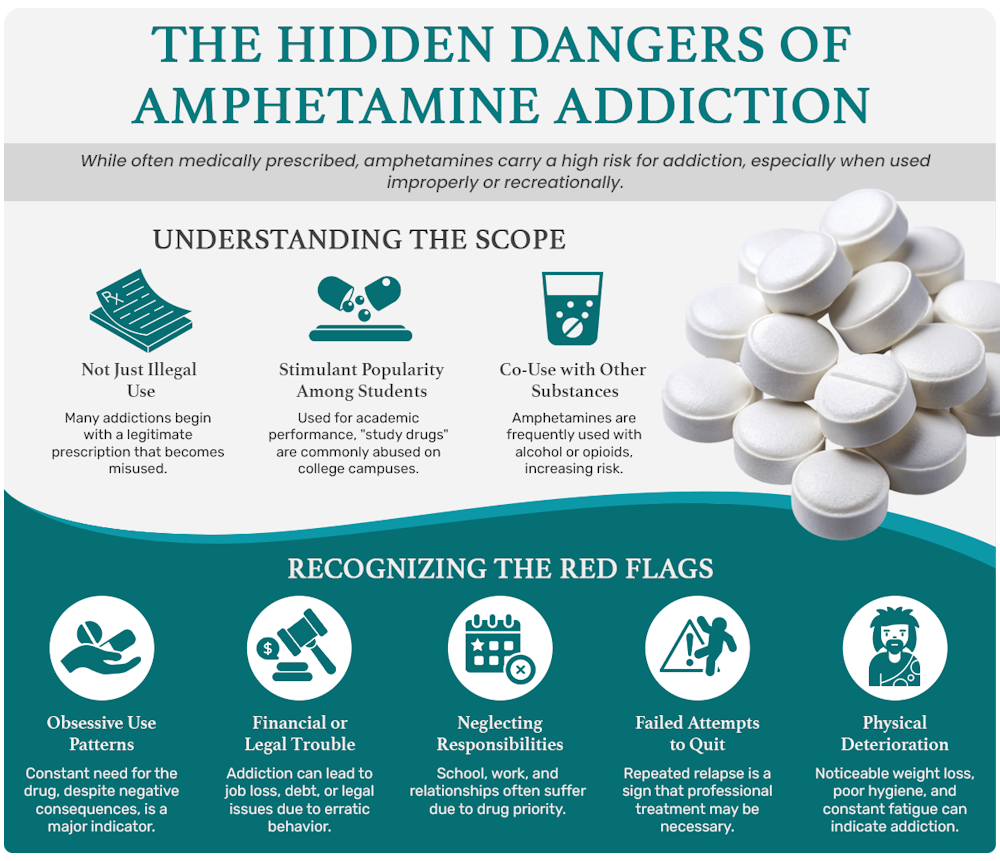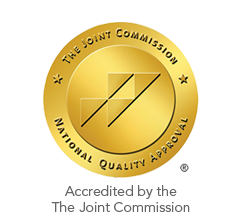Amphetamine Addiction
Amphetamines have been in the United States since the 1930s. Doctors first marketed the amphetamine Benzedrine as a medicine to relieve nasal congestion. Later versions of the drug included pills that people took to try to beat narcolepsy, a sleep disorder.
Manufacturers make these stimulants legally in the United States to treat medical conditions such as attention-deficit hyperactivity disorder. People can also use it illegally, either by themselves or by mixing it with other drugs such as cocaine.
These substances are frequently sought for purposes beyond medical use, including weight management and prolonged wakefulness. Notably, college students represent the demographic that most often misuses these prescription medications.
Approximately 13% of college students in the United States utilize amphetamines, commonly known as “study drugs,” to boost their academic performance. Amphetamines impact the brain’s reward system by promoting the release of dopamine. This can lead individuals to engage in a cycle of seeking the substance, not only to prolong its effects but also to alleviate withdrawal symptoms.

What Do Amphetamines Treat?
The U.S. Food and Drug Administration has authorized specific amphetamines for the management and treatment of ADHD, obesity, and narcolepsy, namely dextroamphetamine and levoamphetamine.
It is essential to administer FDA-approved amphetamines orally, adhering strictly to the guidance provided by your healthcare professional. Always comply with the instructions given by your healthcare provider when using amphetamines. Depending on the specific type and dosage prescribed, extended-release capsules should be taken once daily, while immediate-release tablets and oral solutions may be taken up to three times a day.
Be Brave. Get Help.
Types of Amphetamines
- Dextroamphetamine (Dexedrine)
- Methylphenidate (Ritalin, Ritalin SR)
- Amphetamine and Dextroamphetamine (Adderall)
Common brand names for amphetamines include:
- Concerta
- Focalin
- Metadata
- Methylin
- Ritalin
- Vyvanse
Illegal laboratories also make these stimulants for sale on the street. Street names include:
- Bennies
- Crank
- Speed
- Black beauties
- Ice
- Uppers
Sometimes, illegal laboratories will combine amphetamines with other medications or drugs to try to make them more powerful. FDA-approved amphetamines come in different forms including:
- Immediate-release tablets
- Extended-release capsule
- Oral solution
Healthcare professionals may prescribe amphetamines for individuals diagnosed with ADHD or narcolepsy. Additionally, while less frequently, amphetamines may be utilized in the treatment of obesity.
Difference Between Amphetamines and Methamphetamine?
Amphetamines are classified as prescription medications within the stimulant category, utilized in medical practice to address specific health conditions. Conversely, methamphetamine, another stimulant, is an illegal street drug that lacks any legitimate medical application. Both substances are categorized under the DEA Schedule II due to their potential for abuse and addiction.
Stimulants, in general, accelerate the activity of the central nervous system, leading to heightened respiratory rates, elevated heart rates, and increased blood pressure. Additionally, these substances can enhance energy levels and concentration.
How Do Amphetamines Work?
How Amphetamines Affect the Brain and Body
It is advisable to establish a consistent daily schedule for taking your amphetamines and to adhere to that routine. If you feel that you are developing a dependency on amphetamines or if the prescribed dosage fails to alleviate your symptoms, refrain from exceeding the recommended dosage and consult your healthcare provider without delay.
The Effects of Amphetamine Abuse
Amphetamines may have interactions with other medications you are currently using. It is advisable to consult your healthcare provider regarding the medications you are taking, as they can inform you whether it is safe to initiate amphetamine treatment. Healthcare providers will observe your body’s response to amphetamines to determine their effectiveness in alleviating your symptoms while minimizing potential side effects, particularly the risk of addiction.
Tolerance to the drug can develop gradually, potentially leading to dependence over time. Should you find yourself feeling dependent on amphetamines, it is important to discuss this with your healthcare provider.
Amphetamines can be addictive because of the effects they produce. As stimulants, they act on the central nervous system to produce the following short-term effects:
- Quicker reaction times
- Feelings of energy/wakefulness
- Excitement
- Increased attentiveness and concentration
- Feelings of euphoria
Those seeking the feelings described above may take amphetamines at larger doses than those prescribed or abuse them recreationally. However, the effects of amphetamines on the mind and body aren’t all positive. Abuse of these drugs leads to a range of negative side effects.
Long-term and heavy amphetamine use brings upon:
- Paranoia
- Hallucinations
- Violent behavior
- Cravings for the drug
- Compulsive drug-seeking behavior
- Convulsions
- Respiratory problems
- Loss of coordination
- Obsessive behavior
Long-term use of amphetamines also puts users at higher risk for overdose, which can be fatal. Amphetamine overdose symptoms include:
- Dangerously high blood pressure.
- Chest pain.
- Loss of consciousness.
- Stroke
- Heart attack or other grave cardiac events.
The effects of amphetamine misuse can be extremely severe. If someone you know is exhibiting any of the signs and symptoms listed above, get medical help immediately.
Amphetamine Misuse
They may also enhance their concentration, alertness, and visual and self-awareness. A person may also lose their appetite or lose interest in sleep. Eventually, they may crash because they haven’t slept for some time. Some side effects include higher heart rates, problems sleeping, and appetite loss. They can also feel overwhelmingly tired.
Signs and Symptoms of Amphetamine Addiction
 The symptoms of amphetamine addiction can present in diverse ways, differing among individuals and influenced by the extent of the addiction. Regarding its impact on the brain, amphetamine predominantly functions by enhancing the activity of specific neurotransmitters, especially dopamine and norepinephrine. This enhancement results in improved alertness, heightened concentration, and an uplifted mood.
The symptoms of amphetamine addiction can present in diverse ways, differing among individuals and influenced by the extent of the addiction. Regarding its impact on the brain, amphetamine predominantly functions by enhancing the activity of specific neurotransmitters, especially dopamine and norepinephrine. This enhancement results in improved alertness, heightened concentration, and an uplifted mood.Nevertheless, prolonged use can disturb the natural equilibrium of these neurotransmitters, resulting in tolerance, dependence, and addiction. Elevated doses of amphetamine may exacerbate the previously mentioned side effects and can also result in more serious health issues.
Signs of amphetamine addiction include:
- Increased agitation or irritability
- Paranoia or hallucinations
- Mood swings and emotional instability
- Changes in social circles and withdrawal from family and friends
- Neglect of responsibilities at work, school, or home
- Engaging in risky behaviors to obtain or use amphetamines
- Rapid weight loss or changes in appetite
- Insomnia or irregular sleep patterns
- Dilated pupils and increased heart rate
Symptoms of amphetamine addiction include:
- Despite psychological problems caused or worsened by amphetamine use the individual continues to use the substance
- Improved mood or euphoria
- Increased sociability and self-confidence
- Cravings
- Despite physical or health problems caused or worsened by the drug, the person continues to use the amphetamine
- Tolerance – The individual needs to take more of the substance to achieve the desired effects or continuing to take the same amount results in decreasing effects.
- Increased Respiration
- Increased blood pressure
- Dilated pupils
- Increased energy, decreased fatigue
- Increased alertness
- Decreased appetite
- Increased body temperature
- The drug is taken in larger amounts or over a longer time than intended
- Attempts to cut down are unsuccessful
- A great deal of time is spent obtaining, taking, or recovering from the substance
- Continued use of the substance despite the Inability to fulfill role responsibilities at home, work, or school
- Giving up important activities
- Use in situations the individual knows are dangerous
- Relationship problems caused or worsened by amphetamine use, yet the individual continues to take the drug
- Difficulty with social problem-solving
- When large amounts are used: over-talkativeness, manic-like social presentation, and failure to read social cues
It is crucial to recognize that elevated blood pressure, heightened heart rate, and arrhythmias can trigger severe cardiovascular incidents, potentially leading to fatal outcomes. The combination of amphetamines and alcohol poses significant risks, as these substances exert opposing effects on the central nervous system.
Typically, alcohol acts as a depressant, inhibiting various bodily functions, whereas amphetamines stimulate these processes. The interaction between these two can result in serious health issues, including life-threatening cardiac arrhythmias.
Causes and Risk Factors of Amphetamine Use
- Genetic Factors: Individuals with a family history of substance abuse and addiction are at a heightened risk of developing similar issues later in life. Research indicates that a genetic predisposition may be inherited, particularly among first-degree relatives.
- Brain Chemistry: Addiction to amphetamines may stem from irregularities in the brain’s structure and function. Some researchers suggest that diminished levels of dopamine in the brain could lead individuals who misuse stimulants to seek the euphoric sensations associated with amphetamine use. Variations in the size of specific brain regions may also be observed in those who become addicted.
- Environmental Influences: It is posited that individuals raised in stressful or dysfunctional households are more susceptible to developing addiction in adulthood. Furthermore, an environment where drug use and addiction are normalized can lead individuals to perceive substance abuse as acceptable behavior.
- Psychological Factors: Another perspective posits that many individuals may seek to self-medicate the symptoms of mental health disorders. Prolonged use of amphetamines disrupts the normal balance of dopamine in the brain, resulting in users becoming unable to experience pleasure without the drug over time.
Health Risks of Amphetamine Addiction
In addition to overdose risks, a person could have health complications if they have heart problems. Very fast heart rates could lead to potentially deadly heart rhythms. In addition, if a person uses an injection they place themselves at greater risk for injection-related illnesses. These include Hepatitis C and HIV, as well as endocarditis.
People who have taken stimulants for a long time are at an increased risk of developing a medical condition that is similar to schizophrenia. Doctors call this “amphetamine psychosis.” It causes a person to experience a sensation of paranoia as well as visual and auditory hallucinations. People may start to engage in skin picking and exhibit violent, bizarre, and erratic behavior.
In addition to health risks, a person can experience the side effects of addiction. These include financial, legal, and social problems.
Amphetamine Withdrawal Symptoms
- Anxiety
- Increased appetite
- Problems sleeping well
- Vivid and unpleasant dreams
- Feelings of hopelessness and depression
- Paranoia
- Problems concentrating
- Strong cravings for the drug
Because this type of stimulant is longer lasting in the body than cocaine, a person may experience slightly longer withdrawal symptoms that may last up to 10 days. While the most severe symptoms go away after this time, a person may still experience changes in their mood and strong cravings for weeks, months, or years after quitting. This is why a person must seek continued professional help for substance use disorders.
Stimulant Withdrawal Management and Treatment
Typically, withdrawal symptoms reach their peak within a week and gradually diminish, with an average duration of approximately two weeks. While there are distinctions between the withdrawal symptoms associated with amphetamines and methamphetamines, common symptoms include:
- Excessive sweating
- Severe fatigue
- Intense drug cravings
- Feelings of depression
- Heightened anxiety
- Increased appetite
- Impaired cognitive function
- Disturbing dreams or nightmares
- Excessive sleepiness
- Suicidal thoughts or actions
Methamphetamine addiction presents a more intricate substance use disorder to address compared to amphetamine addiction, primarily due to its significant effects on the brain. Upon completing the detoxification process, the subsequent step in the recovery journey is to participate in a comprehensive treatment program.
Treatment for both types of addiction will encompass individual and group therapy sessions, elements of the 12-step program, holistic practices, life skills development, and health and wellness counseling. After finishing a treatment program, individuals will engage in ongoing care initiatives that support their recovery.
These initiatives may include living in sober housing, attending outpatient therapy sessions, participating in recovery communities, and joining support groups. Involvement in a diverse range of therapeutic activities enables individuals to implement the necessary changes to foster a new life characterized by health and wellness in recovery.
The Relationship Between Amphetamine Addiction and Mental Health
- ADHD
- Anxiety disorders
- Depressive disorders
- Bipolar disorder
- Mood disorders
- Antisocial personality disorders
- Behavioral addictions, like gambling disorder
- Antisocial personality disorder
- Post-traumatic stress disorder (PTSD)
- Other substance abuse disorders
The significant occurrence of comorbidity between substance use disorders and mental health conditions does not inherently imply that one condition is the cause of the other, even if one manifests before the other. Determining causality or the direction of influence presents challenges for multiple reasons. For instance, behavioral or emotional issues may not reach the threshold for a formal diagnosis (referred to as subclinical symptoms), yet these subclinical mental health concerns may lead to substance use.
Additionally, individuals’ memories regarding the onset of drug use or addiction may be flawed, complicating the assessment of whether substance use or mental health issues preceded one another. Three primary pathways can lead to the comorbidity of substance use disorders and mental health conditions:
- Shared risk factors may influence both mental health disorders and substance use or addiction.
- Mental health disorders may lead to increased substance use and addiction.
- Substance use and addiction may result in the emergence of mental health disorders.
Amphetamine Addiction Treatment
Treatment programs designed for amphetamine addiction incorporate various evidence-based behavioral therapies. Laguna Shores offers the following programs:
Medication-assisted treatment (MAT) has gained significant traction as a viable option for individuals in California who are pursuing recovery from addiction. This progressive method integrates the use of FDA-approved medications and therapy to effectively tackle the physical, psychological, and social dimensions of substance use disorders, particularly opioid addiction.
Our MAT program is designed to be flexible and individualized, recognizing that detoxification often serves as the initial phase of the recovery journey before the commencement of a comprehensive treatment program. It is crucial to acknowledge that detoxification alone does not suffice in fully addressing addiction and should be succeeded by a treatment plan customized to cater to the specific needs of each individual.
Inpatient rehabilitation, often referred to as residential treatment, entails residing at the facility within a highly structured and intensive environment. This option may be particularly suitable for individuals facing severe addiction or concurrent mental health issues.
Outpatient treatment typically consists of receiving care for several hours each week, allowing for a more adaptable schedule. This approach is suitable for individuals with mild addiction issues or those who have completed a more intensive treatment program, as it aids in maintaining the progress achieved and reducing the risk of relapse.
Behavioral therapies are typically employed across all levels of addiction treatment, which can be broadly classified into the following categories:
One such approach, cognitive behavioral therapy, assists individuals in examining the connections between their emotions, thoughts, and behaviors while equipping them with strategies for healthier coping mechanisms.
Dialectical behavior therapy (DBT) combines techniques from cognitive therapy, behavioral therapy, and mindfulness approaches. Its primary aim is to equip individuals with essential skills for addressing addiction, including stress management, emotional regulation, and enhancing interpersonal relationships. A fundamental aspect of DBT is the principle of dialectics, which posits that all phenomena consist of opposing elements, and that transformation arises from the dialogue and reconciliation of these conflicting forces.
Individual therapy is a treatment modality in which a person engages in one-on-one sessions with a therapist within a secure and confidential environment. This therapeutic alliance allows individuals to delve into their thoughts, emotions, behaviors, and interpersonal relationships in a supportive, non-judgmental atmosphere. Such therapy can facilitate the development of insight, self-awareness, coping mechanisms, and more adaptive behaviors.
Group therapy represents a method of addiction treatment in which individuals facing comparable difficulties engage in activities collectively, facilitated by a qualified therapist. This approach can play an essential role in a holistic addiction treatment strategy, particularly for those struggling with substance use disorders. The group therapy sessions at Laguna Shores offer a nurturing atmosphere where participants can openly discuss their personal experiences and the challenges they encounter with addiction.
The objective of family therapy in the context of addiction is to enhance communication, fortify relationships, and establish a nurturing environment for the individual undergoing recovery. Engaging the entire family unit allows for the exploration of underlying factors that may be linked to the addiction, thereby facilitating healing for all participants. This approach can encompass a variety of specific issues and subjects.
Contingency management is another effective method, which involves offering tangible rewards for achieving specific, measurable objectives, such as regular participation in treatment or maintaining sobriety.
Treatments for substance misuse are usually supportive and often include talk therapy. The FDA hasn’t approved medications to help with amphetamine withdrawals specifically. However, a person can still experience benefits from professional medical addiction treatment to cope with withdrawals and cravings as they get sober. Also, many people who abuse this drug may use other medications to try and counterbalance some of its effects. Examples include sleeping pills, alcohol, or painkillers to help a person with sleep disturbances.
Recover From Amphetamine Addiction At Laguna Shores Recovery in CA
You don’t have to live with addiction, and it’s never too late to get help. If you or someone you love are struggling with Adderall addiction or addiction to other amphetamines or stimulants, Laguna Shores Recovery in Orange County, CA, is here to help, contact us today.


 Matthew Beck B.A, M.A, LMFT
Matthew Beck B.A, M.A, LMFT 


